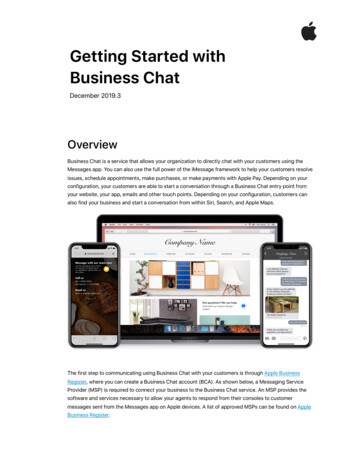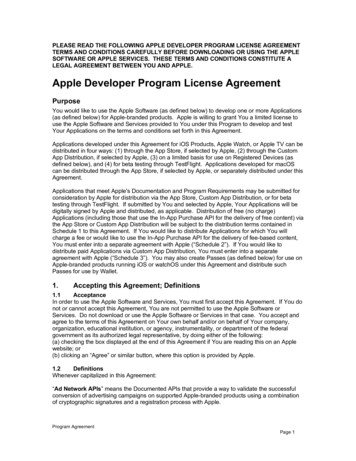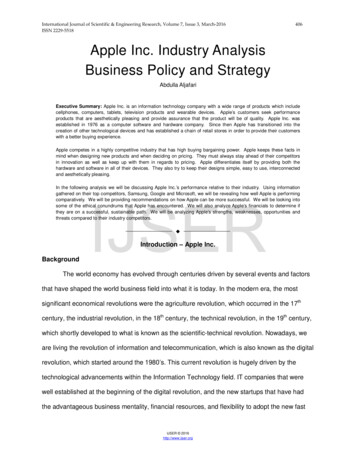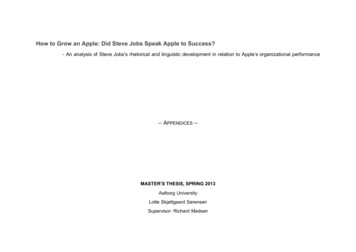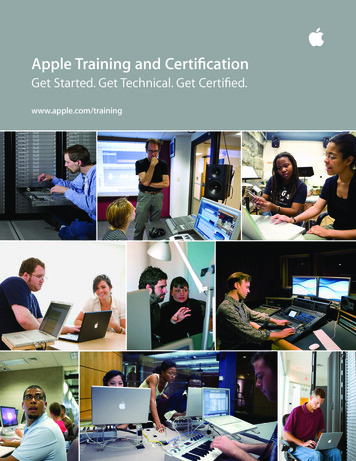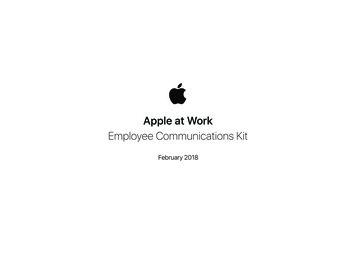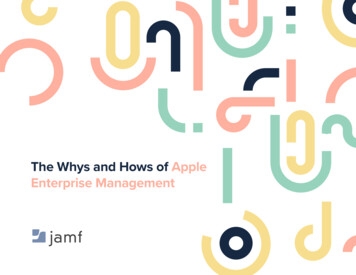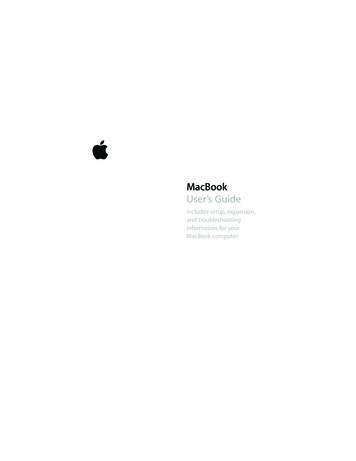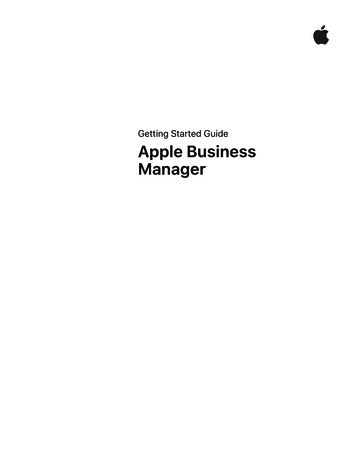
Transcription
Getting Started GuideApple BusinessManager
OverviewOverviewContentsOverviewGetting StartedConfigurationResourcesApple Business Manager is a web-based portal for IT administrators to deployiPhone, iPad, iPod touch, Apple TV, and Mac all from one place. Workingseamlessly with your mobile device management (MDM) solution, AppleBusiness Manager makes it easy to automate device deployment, purchaseapps and distribute content, and create Managed Apple IDs for employees.The Device Enrollment Program (DEP) and the Volume Purchase Program(VPP) are now completely integrated into Apple Business Manager, soorganizations can bring together everything needed to deploy Apple devices.These programs will no longer be available starting December 1, 2019.DevicesApple Business Manager enables automated device enrollment, givingorganizations a fast, streamlined way to deploy corporate-owned Apple devicesand enroll in MDM without having to physically touch or prepare each device. Simplify the setup process for users by streamlining steps in Setup Assistant,ensuring that employees receive the right configurations immediately uponactivation. IT teams can now further customize this experience by providingconsent text, corporate branding or modern authentication to employees. Enable a higher level of control for corporate-owned devices by usingsupervision, which provides additional device management controls that arenot available for other deployment models, including non-removable MDM. More easily manage default MDM servers by setting a default server that’sbased on device type. And you can now manually enroll iPhone, iPad, andApple TV using Apple Configurator 2, regardless of how you acquired them.ContentApple Business Manager enables organizations to easily buy content in volume.Whether your workforce uses iPhone, iPad, or Mac, you can provide greatcontent that’s ready for work with flexible and secure distribution options. Purchase apps, books, and custom apps in bulk, including apps you developinternally. Easily transfer app licenses between locations and share licensesbetween purchasers within the same location. And see a unified listing ofpurchase history, including the current number of licenses in use with MDM. Distribute apps and books directly to managed devices or authorized users,and easily keep track of what content has been assigned to which user ordevice. With managed distribution, control the entire distribution process,while retaining full ownership of apps. Apps that aren’t needed by a device oruser can be revoked and reassigned within the organization. Pay using multiple payment options, including credit cards and purchaseorders. Organizations can buy Volume Credit (where available) from Apple orfrom an Apple Authorized Reseller in specified amounts of local currency,which is delivered electronically to the account holder as store credit.Apple Business ManagerOctober 20192
Overview Distribute an app to devices or users in any country where the app is available,enabling multinational distribution. Developers can make their apps availablein multiple countries through the standard App Store publishing process.Note: Book purchases in Apple Business Manager are not available in certaincountries or regions. To learn which features and purchasing methods areavailable where, visit support.apple.com/HT207305.PeopleApple Business Manager provides organizations with the ability to create andmanage accounts for employees that integrate with existing infrastructure andprovide access to Apple apps and services as well as Apple Business Manager. Create Managed Apple IDs for employees to collaborate with Apple apps andservices, as well as access work data in managed apps that use iCloud Drive.These accounts are owned and controlled by each organization. Leverage federated authentication by connecting Apple Business Managerwith Microsoft Azure Active Directory. Managed Apple IDs will be createdautomatically as each employee signs in for the first time with their existingcredentials on a compatible Apple device. Use Managed Apple IDs on an employee-owned device alongside a personalApple ID with the new User Enrollment features in iOS 13, iPadOS, and macOSCatalina. Alternatively, Managed Apple IDs can be used on any device as theprimary (and only) Apple ID. Managed Apple IDs can also access iCloud on theweb after signing in to an Apple device for the first time. Designate other roles for IT teams in your organization to effectively managedevices, apps and accounts within Apple Business Manager. Use theAdministrator role to accept terms and conditions if needed and easily transferresponsibility if someone leaves the organization.Note: iCloud Drive is not currently supported with User Enrollment. iCloud Drivecan be used with a Managed Apple ID when it is the device’s only Apple ID.Apple Business ManagerOctober 20193
Getting StartedGetting StartedSigning Up for Apple Business ManagerEnrollment is simple and takes only a few minutes, so you can get started withApple Business Manager quickly. Any business is eligible to participate, subjectto the service terms and conditions. Apple reserves the right to determineprogram eligibility for each organization.To get started, complete the online enrollment process and provide informationabout your organization, including name, phone number, and a valid D-U-N-Snumber for your company. D-U-N-S numbers are assigned to qualifiedbusinesses by Dun & Bradstreet (D&B), and are maintained in the D&B database.Click here to look up an existing D-U-N-S number or to obtain a new one. Applewill cross-check program enrollees with the D&B database. If any informationyou provide doesn’t match the information on file with D&B, you’ll be notified soyou can check and correct it. If you feel the information you provided isaccurate, contact D&B to ensure its database records are up to date.You’ll need to provide an email address that’s associated with your business.Consumer email addresses from services such as Gmail or Yahoo Mail won’t beaccepted. The account associated with this email address becomes the initialadministrator for Apple Business Manager and can’t be associated withan existing Apple ID or any other Apple services.Provide a verification contact who can confirm the initial site administrator andverify that they have the authority to bind your organization to the AppleBusiness Manager terms and conditions. This administrator will also beresponsible for accepting the terms and conditions and for setting up additionaladministrators to manage the service on behalf of your company.Apple will review the information you submit on your program enrollment form.During the review process, you and your verification contact may be asked foradditional information by phone or email before your enrollment is approved.Make sure that filters allow mail from all apple.com domains. Return missedphone calls or emails quickly so the enrollment process can proceed smoothly.When your business is approved, the verification contact will receive an emailrequesting that they confirm the initial administrator or delegate administration.After confirmation, the administrator will be asked to create the initial administratorManaged Apple ID and agree to the Apple Business Manager agreement andany additional terms and conditions.Apple Business ManagerOctober 20194
Getting StartedUpgrading to Apple Business ManagerIf your organization currently uses the legacy Device Enrollment Program orVolume Purchase Program, you need to upgrade to Apple Business Managerbefore December 1, 2019. For more information, visit support.apple.com/HT208817If your organization is already enrolled in Apple Deployment Programs, youcan upgrade by logging in to deploy.apple.com using your Apple DeploymentPrograms Agent account and following the onscreen instructions. The upgradeprocess takes only a few minutes. After you upgrade, Apple Business Managerwill have your accounts, MDM servers, devices, server tokens, device orders,and other items associated with your account.Your organization might have one or more separate VPP accounts. If you haveVPP Purchasers that were not included when you upgraded to Apple BusinessManager, learn how to invite them into Apple Business Manager by visitingsupport.apple.com/HT208817.After you upgrade to Apple Business Manager, you’ll no longer have access tothe Apple Deployment Programs website.Apple Business ManagerOctober 20195
ConfigurationConfigurationNow that your organization has enrolled in Apple Business Manager, you canadd additional accounts, enter purchase information, and assign roles to beginmanaging devices and content.Create additional administrators and assign rolesAt first login, the initial administrator will be alerted that only one administratoraccount exists. To create additional administrators:1. Click Accounts in the sidebar.2. Click the Add a new account button at the top of the window.3. Enter the required information, which includes first and last name,Managed Apple ID, administrator role and location, and email address.4. If necessary, enter the middle name, which is optional.5. Click Save at the bottom right of the window.Every Apple Business Manager account has one or more roles assigned to it,which define what the user of the account can do. For example, an accountmight have the roles of both Device Manager and Content Manager.In addition, certain roles can manage other roles. For example, an account withthe role of People Manager can act on an account that has the role of ContentManager. In this way, the People Manager role can also buy apps and books.It’s a good idea to plan role assignments and review role types before creatingaccounts and assigning privileges.Configure Federated AuthenticationYou can use federated authentication to link Apple Business Manager to yourinstance of Microsoft Azure Active Directory (AD). As a result, your users canleverage their Microsoft Azure AD user names and passwords as ManagedApple IDs. They can then use their Microsoft Azure AD credentials to sign in to acompatible Apple device and even iCloud on the web. To get started:1. In Apple Business Manager, sign in with an account that has the role ofAdministrator or People Manager.2. Go to Accounts under Settings and click Edit in the Federated Authenticationsection, then click Connect.3. Select "Sign in to Microsoft Azure" using an account with Microsoft Azure ADGlobal Administrator, Application Administrator, or Cloud ApplicationAdministrator administrative role.4. Enter the domain name you want to use. Only domains that haven’t beenclaimed by another organizations can be added to federation.5. Select "Open Microsoft Sign In" and enter credentials for a Microsoft AzureAD Global Administrator, Application Administrator, or Cloud ApplicationAdministrator account that exists in the domain specified in the previous step.Apple Business ManagerOctober 20196
ConfigurationWhen you configure federated authentication, Apple Business Manager checksto learn whether your domain name is already part of any existing Apple IDs. Ifsomeone else is using an Apple ID that contains the domain you want to use,that Apple ID user name can be reclaimed from the user so that yourorganization can use it. For more information, visit support.apple.com/HT209349If you have existing Managed Apple IDs, you can migrate them to federatedauthentication by changing their details to match the federated domain andusername. If a different organization has Managed Apple IDs in the domain thatyou want to use, Apple will investigate who owns the domain and notify youwhen the investigation is complete. If more than one organization has a validclaim to the domain, no organization can federate it.After you’ve completed a successful administrator account sign-in and the username conflict check is complete, you can turn on federated authentication bydoing the following:1. In Apple Business Manager, sign in with an account that has the role ofAdministrator or People Manager.2. Select Settings at the bottom of the sidebar, select Accounts, then select Editin the Federated Authentication section.3. Turn on federated authentication for the domains that have been successfullyadded to Apple Business Manager.For more information about setting up federated authentication with MicrosoftAzure AD, visit the Apple Business Manager User Guide at er purchase informationTo use automated device enrollment, you’ll need to review and update theinformation regarding how you purchase devices. Select Device ManagementSettings, then add your Apple Customer Number or Reseller ID. If yourorganization purchases directly from Apple and from a participating AppleAuthorized Reseller or carrier, you should enter both your Apple CustomerNumber and the reseller’s Reseller ID. Apple Customer Number. If you purchase hardware or software directlyfrom Apple, your organization is assigned an account number. This number isrequired to connect eligible orders and devices to Apple Business Manager.If you don’t know the number, contact your purchasing agent or financedepartment. Your organization might have multiple Apple Customer Numbers,which you can add into Apple Business Manager once you’re approved. Organization ID. Once enrolled in the program, you’ll be assigned anOrganization ID, found in Apple Business Manager in the Settings section. Ifyou purchase Apple devices from a participating Apple Authorized Reseller orcarrier, you'll need to provide this number to the reseller or carrier to enrollyour device purchases into Apple Business Manager.Apple Business ManagerOctober 20197
Configuration Reseller ID. If you purchase hardware or software directly from a participatingApple Authorized Reseller or carrier, you’ll need to provide your reseller’sReseller ID. If you don’t know this number, contact your reseller. If youpurchase from multiple resellers, enter the Reseller ID of each. You must alsoprovide your Organization ID to your reseller so that they can submit your devicepurchases. Providing the Reseller ID alone is insufficient to enroll your devicesin Apple Business Manager. Apps and Books. To enable app and book purchases, go to Apps and Booksunder Settings. Follow the steps to agree to the Apps and Books terms and toupdate billing information. You can also review purchase history and transferpurchases from one location to another in Apps and Books settings.Manage device assignmentsApple Business Manager integrates all the existing features from the DeviceEnrollment Program (DEP). Additionally, MDM servers can now be set as defaultbased on device type, enabling you to set one server as default for Mac andanother as default for iPhone and iPad.Link your MDM solution. To link your MDM solution go to Settings DeviceManagement Settings, you’ll establish a connection to your MDM server orservers. Servers listed in Apple Business Manager are linked to your physical MDMservers. You can add servers at any time.Add a new MDM server by providing a name and authorization information. Eachserver must be known to Apple and authorized to manage your devices. A twostep verification process is used to securely authorize an MDM server. YourMDM vendor can provide documentation on the specifics for implementation.Assign devices. You can assign devices to your servers by order number or byserial number. Only eligible devices will be available for assignment to your MDMserver on the program website.You can search for orders you placed directly with Apple after March 1, 2011,either by order or by serial number. If you’ve placed orders from a participatingApple Authorized Reseller or carrier, your look-back period will be at thediscretion of the reseller. Your order will be available in Apple Business Managerwithin 24 hours after the reseller successfully posts it.You can also download a comma-separated value (CSV) file that contains thefull list of all devices in a specific order or orders. Devices are listed by serialnumber in the CSV file. By typing ‘All Available’ in the order field, a completelisting of all of the devices will be available. By designating a MDM server as thedefault, you can automatically assign newly purchased devices to it.If you’ve acquired devices from sources other than Apple or participating AppleAuthorized Resellers or carriers, they can also be added to Apple BusinessManager using Apple Configurator 2. Manually enrolled devices you set upbehave like any other enrolled device, with mandatory supervision and MDMenrollment. However, the user has a 30-day provisional period to remove thedevice from enrollment, supervision, and MDM.Apple Business ManagerOctober 20198
ConfigurationLearn more about how to manually enroll devices: bc2a859Note: Per the terms of the agreement, devices that are sold, lost, returned to thereseller, or otherwise retired from service should be permanently removed fromyour organization’s list of managed devices using Apple Business Manager.However, once a device is removed, it can’t be added back again, unless it isenrolled manually through Apple Configurator 2 for supported devices.Review assignments. Once you’ve set up your MDM servers and assigneddevices, you can review several aspects of your device assignment, including: Assignment date Order numbers Name of the MDM server to which the devices are assigned Total number of devices, listed by device typePurchase contentApple Business Manager provides a streamlined purchasing process. You cansearch for content, specify the quantity you want to purchase, and quicklycomplete the transaction using VPP Credit or a corporate credit card.Search for an app or a book. To narrow your search options, select media typeiOS and iPadOS apps, Mac apps, or Books. Click the Category pull-down menuto find apps and books by category. Universal apps that work on both iPhoneand iPad are identified with the universal badge.Enter the quantity. Once you’ve found the content you’re interested in, selectthe name in the search list, review the content details, and enter the quantityyou want to purchase.Distribute and download contentWith managed distribution, use your MDM solution or Apple Configurator 2 tomanage apps and books distribution.Link your MDM solution. To use MDM for distribution, you must first link yourMDM solution to a location in Apple Business Manager using a secure token. Todownload your token, go Settings Apps and Books and select the appropriatelocation token. Upload this token to your MDM server to establish the link.Note: Secure tokens expire after one year.If you're using Apple Configurator 2 to manage devices and content, simplysign in with the applicable Content Manager account using the Account menu.With iOS 10 and macOS Sierra and later, you can save time and networkbandwidth by preloading apps for all your deployments through this method.Once connected to your MDM server, you can assign apps and books—including newly assigned apps and app updates—in a variety of ways to devicesand users, even if the App Store is disabled.Apple Business ManagerOctober 20199
ConfigurationAssign apps to devices. If your organization needs to retain full control overmanaged devices and content, or if it’s not practical for every user to obtain anApple ID, you can assign apps directly to devices using your MDM solution orApple Configurator 2. After an app is assigned to a device, it‘s pushed to thatdevice by MDM or added by Apple Configurator 2; no invitation is required.Anyone using that device has access to the app. To assign apps to devices,you’ll need one managed distribution license per device.Assign apps and books to users. Use your MDM solution to invite usersthrough email or a push notification message. To accept the invitation, userssign in on their devices with a personal Apple ID. Although your business canassign apps and books to a user’s Apple ID, the Apple ID remains completelyprivate and not visible to the administrator. Once users agree to the invitationand accept the terms and conditions, they’re connected to your MDM serverand they can download assigned apps and books. Or you can install the appsilently on supervised iOS and iPadOS devices. Assigned apps are automaticallyavailable for download on all of a user’s devices, with no additional effort or costto you. To assign apps and books to users, you’ll need one managed distributionlicense per user.Note: If you previously assigned apps to users, MDM solutions can perform asilent migration from per-user assignments to per-device assignments. Thedevice must be enrolled in an MDM solution. Refer to your MDM solution’sdocumentation for support.Revoke and reassign apps. When apps you’ve assigned are no longer neededby a device or a user, you can revoke and reassign them to different devices orusers. If the app is assigned to a user, the user will have the opportunity to buya personal copy. If the app was deployed as a managed app with MDM for iOS oriPadOS, the administrator has the additional option of removing the app and alldata immediately. In this case, it’s a best practice to give users some notice or agrace period before removing apps from their devices. Once distributed, booksremain the property of the recipient and can’t be revoked or reassigned.Important Information about app assignmentAdmins can assign apps to devices in any country or region where an app is soldthrough the App Store. For example, an app purchased from an account in theUnited States can be assigned to devices or users in France as long as the appis available through the App Store in France.You can use an MDM solution to assign apps only to users whose devices arerunning iOS 7 or later and macOS 10.9 or later. Assigning apps directly todevices without an Apple ID requires iOS 9 or later and macOS 10.10 or later.Purchase and distribute custom appsBy collaborating with a third-party developer, you can have unique iOS andiPadOS apps tailored to your business needs, then distribute them at scale toyour organization along with off-the-shelf App Store apps—further extendingthe use of iPhone and iPad. Whether you outsource development to anindependent contractor or a commercial developer, or distribute your own appsinternally, distributing custom apps through Apple Business Manager is thesimplest method for both you and your organization.Apple Business ManagerOctober 201910
ConfigurationCustom apps built for your business are made available to only you; no otherorganization can see or get them, making the transaction both secure andprivate. Apple reviews custom apps before they're available to your account, soyou can be assured that they’ve been verified technically and checked forquality. Pricing for custom apps is set by the developer or designated as free.Common ways to customize apps include incorporating company branding intothe user interface or adding unique capabilities that are pertinent to a businessprocess or workflow. Developers can also add a specific configuration for yourenvironment or add features tailored to a business partner, dealer, or franchise.Work with your developer. To get started, get in touch with a developer.Developers who are registered in the Apple Developer Program and who haveagreed to the latest Program License Agreement can submit apps for customapp distribution through App Connect. If your preferred developer or businesspartner isn’t registered in the Apple Developer Program, refer them todeveloper.apple.com/programs to enroll. Once the developer has created an appand identified you as the authorized purchaser, they can offer the app for free orset a price just for you. Provide your developer with either the Organization IDfrom Apple Business Manager or the Managed Apple ID of your administrator.Work with your internal app developers. For apps developed in-house, usethe same method described above to distribute a custom app to your ownorganization. This does not require the use of the Developer Enterprise Programand enables your app to take advantage of advanced App Store features likeapp thinning, analytics and more. Additionally, unlike the Developer EnterpriseProgram, there is no need to update and maintain certificates for distribution.Obtain the custom app. Your developer will need to associate the customapp to your organization and will notify you when it’s available for download. Todo this the developer will need your Organization ID which can be found bygoing to Setting Enrollment Information. When you sign in to Apple BusinessManager, you’ll see a Custom Apps section in the sidebar below Content.Custom apps are available to only the businesses specified by the developer andare not visible to other organizations.Important Information about custom apps App review. Each app, as well as each version (update) of the app, submittedfor custom app distribution goes through an app review process with Apple.The same app review guidelines for App Store apps apply to custom apps. App security. If your app contains sensitive business data, you might wantto include an authentication mechanism within the app. Custom apps bythemselves are not secured by Apple, and the security of data within the appis the responsibility of the developer. Apple highly recommends using iOS andiPadOS best practices for in-app authentication and encryption. For moreinformation on secure coding best practices, visit the Developer Library. App verification. To verify that custom apps meet the review guidelines,Apple needs to be able to sign in and operate the app. Work with yourdeveloper or business partner to determine how to meet this requirement withappropriate handling of proprietary or sensitive business data. You might wantto provide test accounts or sanitized sample data to protect confidentiality.Apple Business ManagerOctober 201911
ResourcesResourcesFor more detailed information, view the Apple Business Manager User Guide plore the following for additional information on Apple Business Manager: Apple Business Manager: business.apple.com Apple Business Manager release notes: support.apple.com/HT208802 Upgrading to Apple Business Manager: support.apple.com/HT208817 Learn more about Managed Apple IDs: support.apple.com Learn more about Microsoft Azure AD IT Resources: www.apple.com/business/it/ Business Support: www.apple.com/support/business 2019 Apple Inc. All rights reserved. Apple, the Apple logo, Apple TV, iPad, iPhone, iTunes, Mac, macOS, and Safariare trademarks of Apple Inc., registered in the U.S. and other countries. tvOS is a trademark of Apple Inc. App Store,iCloud, and iTunes Store are service marks of Apple Inc., registered in the U.S. and other countries. IOS is a trademarkor registered trademark of Cisco in the U.S. and other countries and is used under license. Other product and companynames mentioned herein may be trademarks of their respective companies. Product specifications are subject to changewithout notice. October 2019Apple Business ManagerOctober 201912
Apple Business Manager is a web-based portal for IT administrators to deploy iPhone, iPad, iPod touch, Apple TV, and Mac all from one place. Working seamlessly with your mobile device management (MDM) solution, Apple Business Mana

